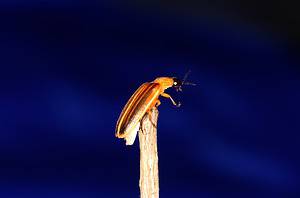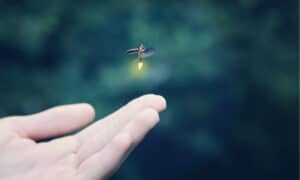Pennsylvania is a large state in the northeast region of the United States with diverse biomes. Its ecosystems include the Appalachian mountains, coastlines, forests, grasslands, and wetlands, so there is a vast array of animal species within Pennsylvania’s borders, including a myriad of insects. Let’s discover the official Pennsylvania state insect, how it came to represent Pennsylvania, and the dark secret its females are hiding!
What Is Pennsylvania’s State Insect?
The official Pennsylvania state insect is the Pennsylvania firefly Photuris pensylvanica. This flashy little bug is also called the lightning bug or the dot-dash firefly. When it’s a larva (more on that later), it’s known as a glow worm.
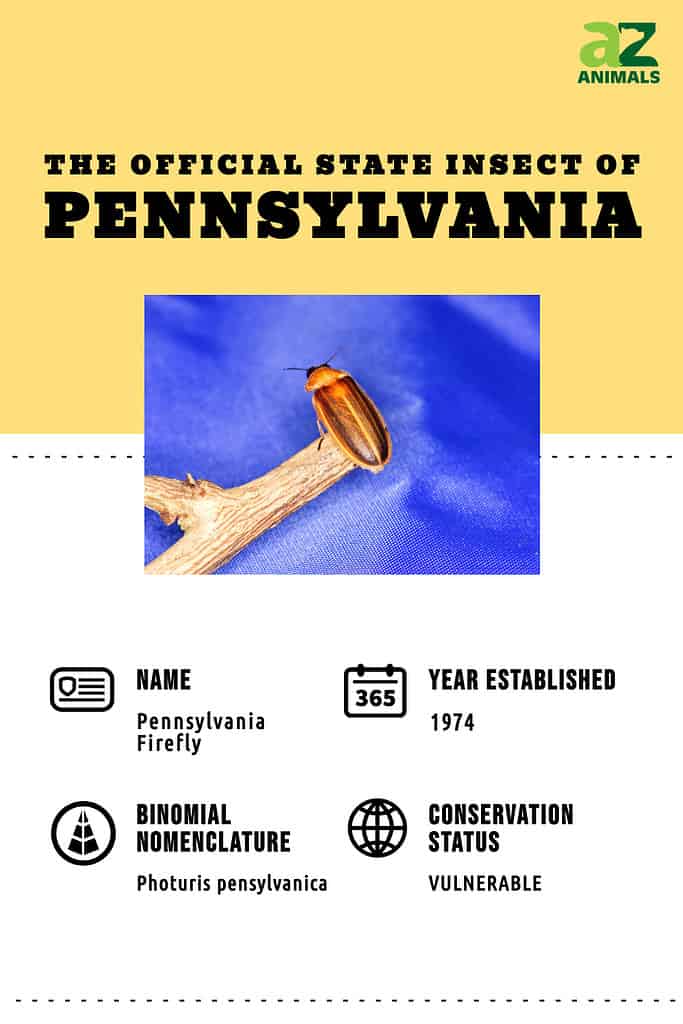
How Did a Firefly Become Pennsylvania’s State Insect?
Pennsylvania’s state insect is the Pennsylvania firefly, thanks to an elementary school campaign carried out in 1974. Highland Park Elementary noted their neighboring state, Maryland, had a state insect, but Pennsylvania did not. The school kids thought the Pennsylvania firefly was suitable and petitioned Pennsylvania’s General Assembly, made bumper stickers, and wrote letters to garner support.
Their persistence paid off because, on April 19, 1974, Governor Milton Shapp officially named Photuris pensylvanica as the official Pennsylvania state insect. Highland Park School proudly displays a bronze plaque immortalizing their successful effort.
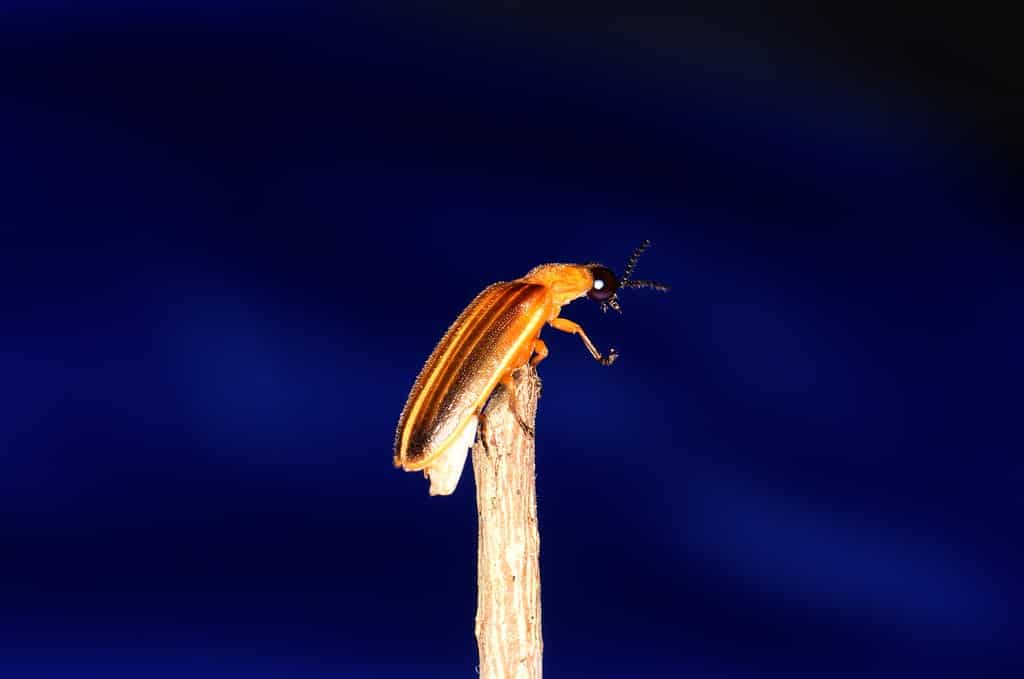
The Pennsylvania firefly is the official Pennsylvania state insect.
©glebantiy/Shutterstock.com
What Is a Firefly?
Fireflies are soft-bodied beetles in the Lampyridae family, so they are not actually flies at all. Lampyridae is the Greek word for “lamp,” nodding to their lighting-up ability.
There are 2,000 species in the Lampyridae family and 60 in the Photuris genus, including the Pennsylvania firefly. North America has about 50 known species of fireflies overall.
The oldest ever firefly fossil we know of dates to the late Cretaceous over 99 million years ago. It’s preserved in amber (hardened tree sap), and its light-producing parts are clear to see, so we know fireflies have been lighting up our skies for millions of years.
Unfortunately, these mesmerizing insects are under threat today due to habitat loss, light pollution, invasive species, and poor water quality. Firefly tourism also takes a toll. People love fireflies and want to witness their annual displays, but tourism puts a lot of pressure on their environment. The IUCN classifies Pennsylvania fireflies as vulnerable, which means their population is decreasing.
Species Overview
Let’s delve a little deeper and uncover the fascinating beetle that’s become the official Pennsylvania state insect.
Native Range
Photuris pensylvanica is native to the United States and Canada from the eastern U.S. to Kansas and Texas.
Habitat
Fireflies live in temperate and tropical areas, close to standing freshwater, such as marshland, fens, wet woods, and ponds. Pennsylvania fireflies usually live in meadows and open woods beside a pond or marsh.
As larvae, they burrow into moist leaf litter, tree bark, and rotting vegetation, but as adults, they prefer to shelter beneath the foliage. Adult males climb grass blade tips at night and fly into tree branches before signaling to potential mates. This cautious approach conceals them from predators and creates a long vantage point, enabling more females to spot their flashes. Most species of fireflies live on the ground, only flying to attract mates.
Appearance
It’s a flat-looking firefly up to 0.59 inches long with a hard exoskeleton. It’s mostly black with a yellow or orange strip and a rounded thorax edged in yellow. The thorax has two red dots illuminating either side. When its abdomen lights up, the end segments glow yellow-green.
Adult Pennsylvania fireflies have two gray-brown wings, six jointed legs, two antennae, and a three-part segmented body comprising its head, thorax, and abdomen.

The official Pennsylvania state insect is classified as vulnerable, which means the population is decreasing.
©iStock.com/Hlib Serbskyi
Lifecycle
Like butterflies, fireflies perform complete metamorphosis. This term describes a four-stage lifecycle from egg, larva, chrysalis, and adult. Other animals with complete metamorphosis lifecycles include wasps, bees, dragonflies, flies, and beetles.
Eggs
A fertilized female firefly lays up to 100 spherical pale eggs in damp soil or on top of the soil beneath leaf litter so they don’t dry out. Often, eggs are bioluminescent, so you may spot them dimly glowing if you look carefully.
Larva
A Pennsylvanian firefly egg hatches in late summer. A larva is wormlike with slightly flat plates on its sides and back. These larvae are called glow worms because they are bioluminescent, too.
These little glow worms are cute, but they are rampant carnivores. They live in the soil all winter long, preying on snails, worms, slugs, and any unfortunate insect to cross their path. Before eating, a firefly larva injects a digestive enzyme that breaks down and liquefies its prey. Once enough food is consumed, a Pennsylvanian firefly larva reaches a whopping ¾ of an inch! It sheds its exoskeleton numerous times to get this monstrous size.
Chrysalis
In spring, the satiated larva cocoons its caterpillar-like body into a pupa and goes about the process of turning into an adult firefly. It does this by building a mud chamber beneath the soil and hanging upside down from the roof. In some cases, a larva chooses tree bark to hang from instead.
During its transformation (called histolysis), its body is liquified and rebuilt by histoblasts, an incredible type of transformative cell. After several weeks, an adult firefly breaks free of the cocoon, finally emerging in May or June, depending on rainfall and air temperatures.
Adult Firefly
A newly hatched firefly must harden its wings before it can fly, so it will spread its wings and wait. An adult firefly’s purpose is to find a mate, and it does this through a series of bioluminescent flashes that are specific to its species.
Adults emerge during warm, humid weather because the dampness helps eggs survive. If winter is mild, they can show up in Pennsylvania as early as March.
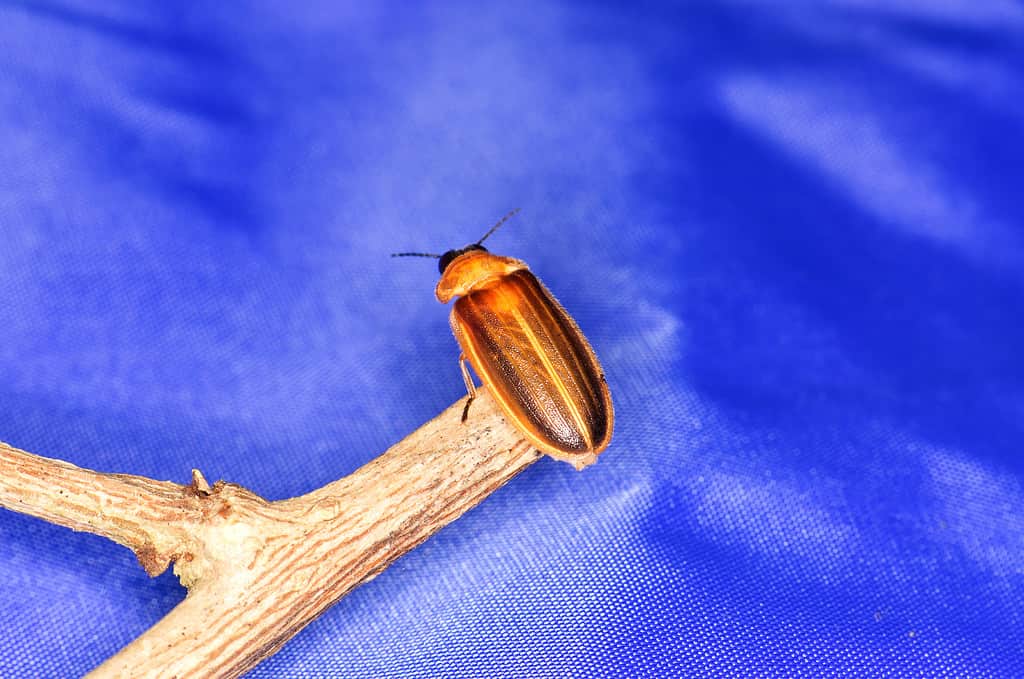
When the firefly’s abdomen lights up, the end segments glow yellow-green.
©iStock.com/Hlib Serbskyi
Predators
In its egg stage, a firefly is predated by birds and insects. In its larva form, birds, lizards, small mammals, and amphibians eat them. However, larvae release a distasteful chemical to deter predators.
Adult fireflies are preyed on by birds, bats, spiders, and amphibians, but they, too, produce smelly chemicals, so a predator lets go after one taste.
Why Do Fireflies Light Up?
Pennsylvanian fireflies are the state insects because thousands produce synchronous flashes, which is a spectacular summertime display. Pennsylvania is known for its annual firefly display attended by thousands of people. It lasts from the summer solstice to July’s second week. Fifteen different species can be witnessed signaling to potential mates, including the official Pennsylvania state insect, the Pennsylvanian firefly.
But fireflies don’t light up for our amusement. They have more pressing reasons.
Fireflies light up to attract a mate. Males fly and signal to females resting on foliage. Receptive females flash back to attract his attention. When a pair successfully finds one another, they mate.
But there’s a darker reason for female bioluminescent flashing in some species. Pennsylvanian firefly females are guilty of luring males to their death! Females flash signals that attract males from other firefly species. When they approach her, expecting to find a receptive female of their own species, she eats them!
Experts think female Photuris fireflies do this because they can’t make defensive chemicals. By eating other species’ males, she hijacks his chemicals and makes a distasteful chemical to repel predators.
How Do Pennsylvania Fireflies Flash?
Lightning bugs light up using an enzyme called luciferase mixed with oxygen. It’s incredibly efficient, producing a bright flash of green-yellow light every few seconds without creating heat. The ability is called bioluminescence.
Fireflies have bioluminescent organs on their abdomen tip. Still, each species produces a different flash pattern, as we’ve seen in the male-eating Pennsylvanian firefly females, who mimic other species’ patterns to eat them.
Photuris pensylvanica males emit a characteristic dot-dash flash pattern followed by a long three-second flash, and receptive females flash it back – or a different pattern if they’re feeling peckish.

The Pennsylvania firefly has bioluminescent organs, causing them to light up.
©iStock.com/Hlib Serbskyi
Pennsylvania’s Official State Insect
Let’s recap!
The official state insect of Pennsylvania is Photuris pensylvanica, but it’s better known as the Pennsylvania firefly or lightning bug. It’s a native insect that produces an incredible synchronous bioluminescent display in summer but spends most of its life as a larva beneath the leaf litter. Talk about a glow-up!
The photo featured at the top of this post is © iStock.com/rarrarorro
Thank you for reading! Have some feedback for us? Contact the AZ Animals editorial team.



